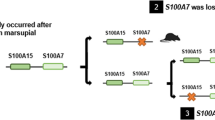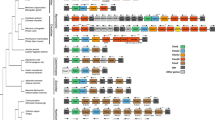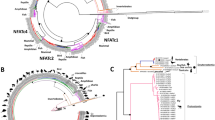Abstract
The human S100A7 resides in the epidermal differentiation complex (EDC) and has been described as a key effector of innate immunity. In humans, there are five S100A7 genes located in tandem—S100A7A, S100A7P1, S100AL2, S100A7, and S100AP2. The presence of several retroelements in the S100A7A/S100A7P1 and S100A7/S100A7P2 clusters suggests that these genes were originated from a duplication around ~ 35 million years ago, during or after the divergence of Platyrrhini and Catarrhini primates. To test this hypothesis, and taking advantage of the high number of genomic sequences available in the public databases, we retrieved S100A7 gene sequences of 12 primates belonging to the Cercopithecoidea and Hominoidea (Catarrhini species). Our results support the duplication theory, with at least one gene of each cluster being identified in both Cercopithecoidea and Hominoidea species. Moreover, given the presence of an ongoing gene conversion event between S100A7 and S100A7A, a high rate of mutation in S100A7L2 and the presence of pseudogenes, we proposed a model of concerted and birth-and-death evolution to explain the evolution of S100A7 gene family. Indeed, our results suggest that S100A7L2 most likely suffered a neofunctionalization in the Catarrhini group. Being S100A7 a major protein in innate defense, we believe that our findings could open new doors in the study of this gene family in immune system.



Similar content being viewed by others
References
Assis R, Bachtrog D (2013) Neofunctionalization of young duplicate genes in Drosophila. Proc Natl Acad Sci U S A 110:17409–17414. https://doi.org/10.1073/pnas.1313759110
Denessiouk K, Permyakov S, Denesyuk A, Permyakov E, Johnson MS (2014) Two structural motifs within canonical EF-hand calcium-binding domains identify five different classes of calcium buffers and sensors. PLoS One 9:e109287. https://doi.org/10.1371/journal.pone.0109287
Donato R, Cannon BR, Sorci G, Riuzzi F, Hsu K, Weber DJ, Geczy CL (2013) Functions of S100 proteins. Curr Mol Med 13:24–57
Engelkamp D, Schafer BW, Mattei MG, Erne P, Heizmann CW (1993) Six S100 genes are clustered on human chromosome 1q21: identification of two genes coding for the two previously unreported calcium-binding protein S100D and protein S100E. Proc Natl Acad Sci U S A 90:6547–6551. https://doi.org/10.1073/pnas.90.14.6547
Esteves PJ, Lanning D, Ferrand N, Knight KL, Zhai SK, van der Loo W (2005) The evolution of the immunoglobulin heavy chain variable region (IgV H ) in Leporids: an unusual case of transspecies polymorphism. Immunogenetics 57:874–882. https://doi.org/10.1007/s00251-005-0022-0
Gläser R, Harder J, Lange H, Bartels J, Christophers E, Schroder JM (2005) Antimicrobial psoriasin (S100A7) protects human skin from Escherichia coli infection. Nat Immunol 6:57–64. https://doi.org/10.1038/ni1142
Gläser R, Meyer-Hoffert U, Harder J, Cordes J, Wittersheim M, Kobliakova J, Fölster-Holst R, Proksch E, Schröder JM, Schwarz T (2009) The antimicrobial protein psoriasin (S100A7) is upregulated in atopic dermatitis and after experimental skin barrier disruption. J Invest Dermatol 129:641–649. https://doi.org/10.1038/jid.2008.268
Goodwin ZA, de Guzman Strong C (2017) Recent positive selection in genes of the mammalian epidermal differentiation complex locus. Front Genet 7:227. https://doi.org/10.3389/fgene.2016.00227
Gordon D, Huddleston J, Chaisson MJP, Hill CM, Kronenberg ZN, Munson KM, Malig M, Raja A, Fiddes I, Hillier LW, Dunn C, Baker C, Armstrong J, Diekhans M, Paten B, Shendure J, Wilson RK, Haussler D, Chin CS, Eichler EE (2016) Long-read sequence assembly of the gorilla genome. Science 352:aae0344. https://doi.org/10.1126/science.aae0344
Hall TA (1999) BioEdit: a user-friendly biological sequence alignment editor and analysis program for Windows 95/98/NT. In: Nucleic acids symposium series, 1999. vol 41. [London]: Information Retrieval Ltd., c1979-c2000., pp 95–98
Hoffmann HJ, Olsen E, Etzerodt M, Madsen P, Thøgersen HC, Kruse T, Celis JE (1994) Psoriasin binds calcium and is upregulated by calcium to levels that resemble those observed in normal skin. J Invest Dermatol 103:370–375
Ishikawa K, Nakagawa A, Tanaka I, Suzuki M, Nishihira J (2000) The structure of human MRP8, a member of the S100 calcium-binding protein family, by MAD phasing at 1.9 A resolution. Acta Crystallogr Sect D Biol Crystallogr 56:559–566. https://doi.org/10.1107/s0907444900002833
Karev GP, Wolf YI, Koonin EV (2006) Birth and death models of genome evolution. In: Power laws, scale-free networks and genome biology. Springer US, Boston, MA, pp 65–85. https://doi.org/10.1007/0-387-33916-7_6
Kuderna LFK, Tomlinson C, Hillier LDW, Tran A, Fiddes IT, Armstrong J, Laayouni H, Gordon D, Huddleston J, Garcia Perez R, Povolotskaya I, Serres Armero A, Gómez Garrido J, Ho D, Ribeca P, Alioto T, Green RE, Paten B, Navarro A, Betranpetit J, Herrero J, Eichler EE, Sharp AJ, Feuk L, Warren WC, Marques-Bonet T (2017) A 3-way hybrid approach to generate a new high-quality chimpanzee reference genome (Pan_tro_3.0). GigaScience 6:1–6. https://doi.org/10.1093/gigascience/gix098
Kulski JK, Lim CP, Dunn DS, Bellgard M (2003) Genomic and phylogenetic analysis of the S100A7 (psoriasin) gene duplications within the region of the S100 gene cluster on human chromosome 1q21. J Mol Evol 56:397–406. https://doi.org/10.1007/s00239-002-2410-5
Kumar S, Stecher G, Tamura K (2016) MEGA7: molecular evolutionary genetics analysis version 7.0 for bigger datasets. Mol Biol Evol 33:1870–1874. https://doi.org/10.1093/molbev/msw054
Lee KC, Eckert RL (2007) S100A7 (Psoriasin) - mechanism of antibacterial action in wounds. J Invest Dermatol 127:945–957. https://doi.org/10.1038/sj.jid.5700663
Liu GJ, Wu Q, Liu GL, Song XY, Zhang JH (2015) Psoriasin (S100A7) is a novel biomarker for lung squamous cell carcinoma in humans. Cancer Cell Int 15(9). https://doi.org/10.1186/s12935-014-0154-0
Madsen P, Rasmussen HH, Leffers H, Honoré B, Dejgaard K, Olsen E, Kiil J, Walbum E, Andersen AH, Basse B, Lauridsen JB, Ratz GP, Celis A, Vandekerckhove J, Celis JE (1991) Molecular-cloning, occurrence, and expression of a novel partially secreted protein psoriasin that is highly up-regulated in psoriatic skin. J Invest Dermatol 97:701–712. https://doi.org/10.1111/1523-1747.ep12484041
Magadum S, Banerjee U, Murugan P, Gangapur D, Ravikesavan R (2013) Gene duplication as a major force in evolution. J Genet 92:155–161. https://doi.org/10.1007/s12041-013-0212-8
Mano S, Innan H (2007) The evolutionary rate of multigene family under concerted evolution. Genes Genet Syst 82:530–530
Marenholz I, Heizmann CW, Fritz G (2004) S100 proteins in mouse and man: from evolution to function and pathology (including an update of the nomenclature). Biochem Biophys Res Commun 322:1111–1122. https://doi.org/10.1016/j.bbrc.2004.07.096
Moroz OV, Antson AA, Dodson GG, Wilson KS, Skibshoj I, Lukanidin EM, Bronstein IB (2000) Crystallization and preliminary X-ray diffraction analysis of human calcium-binding protein S100A12. Acta Crystallogr Sect D Biol Crystallogr 56:189–191. https://doi.org/10.1107/s0907444999014936
Nei M, Gu X, Sitnikova T (1997) Evolution by the birth-and-death process in multigene families of the vertebrate immune system. Proc Natl Acad Sci U S A 94:7799–7806. https://doi.org/10.1073/pnas.94.15.7799
Nei M, Rooney AP (2005) Concerted and birth-and-death evolution of multigene families. Annu Rev Genet 39:121–152. https://doi.org/10.1146/annurev.genet.39.073003.112240
Norgren RB (2013) Improving genome assemblies and annotations for nonhuman primates. ILAR J 54:144–153. https://doi.org/10.1093/ilar/ilt037
Otto SP, Yong P (2002) The evolution of gene duplicates. In: Advances in genetics, vol 46. Elsevier, pp 451–483
Rastogi S, Liberles DA (2005) Subfunctionalization of duplicated genes as a transition state to neofunctionalization. BMC Evol Biol 5:28–28. https://doi.org/10.1186/1471-2148-5-28
Rogers J (2013) In transition: primate genomics at a time of rapid change. ILAR J 54:224–233. https://doi.org/10.1093/ilar/ilt042
Rogers J, Gibbs RA (2014) Comparative primate genomics: emerging patterns of genome content and dynamics. Nat Rev Genet 15:347–359. https://doi.org/10.1038/nrg3707
Ruse M, Broome AM, Eckert RL (2003) S100A7 (psoriasin) interacts with epidermal fatty acid binding protein and localizes in focal adhesion-like structures in cultured keratinocytes. J Invest Dermatol 121:132–141. https://doi.org/10.1046/j.1523-1747.2003.12309.x
Salama I, Malone PS, Mihaimeed F, Jones JL (2008) A review of the S100 proteins in cancer. Ejso 34:357–364. https://doi.org/10.1016/j.ejso.2007.04.009
Santamaria-Kisiel L, Rintala-Dempsey AC, Shaw GS (2006) Calcium-dependent and independent interactions of the S100 protein family. Biochem J 396:201–214. https://doi.org/10.1042/bj20060195
Schrago CG, Russo CAM (2003) Timing the origin of New World monkeys. Mol Biol Evol 20:1620–1625. https://doi.org/10.1093/molbev/msg172
Schröder JM, Harder J (2006) Antimicrobial skin peptides and proteins. Cell Mol Life Sci 63:469–486. https://doi.org/10.1007/s00018-005-5364-0
Tamura K, Nei M (1993) Estimation of the number of nucleotide substitutions in the control region of mitochondrial DNA in humans and chimpanzees. Mol Biol Evol 10:512–526. https://doi.org/10.1093/oxfordjournals.molbev.a040023
Tan JQ et al (1996) Psoriasin: a novel chemotactic protein. J Invest Dermatol 107:5–10
Teshima KM, Innan H (2008) Neofunctionalization of duplicated genes under the pressure of gene conversion. Genetics 178:1385–1398. https://doi.org/10.1534/genetics.107.082933
Thompson JD, Higgins DG, Gibson TJ (1994) CLUSTAL W: improving the sensitivity of progressive multiple sequence alignment through sequence weighting, position-specific gap penalties and weight matrix choice. Nucleic Acids Res 22:4673–4680
Webb M, Emberley ED, Lizardo M, Alowami S, Qing G, Alfia'ar A, Snell-Curtis LJ, Niu Y, Civetta A, Myal Y, Shiu R, Murphy LC, Watson PH (2005) Expression analysis of the mouse S100A7/psoriasin gene in skin inflammation and mammary tumorigenesis. BMC Cancer 5:16. https://doi.org/10.1186/1471-2407-5-17
Wolf R, Voscopoulos CJ, FitzGerald PC, Goldsmith P, Cataisson C, Gunsior M, Walz M, Ruzicka T, Yuspa SH (2006) The mouse S100A15 ortholog parallels genomic organization, structure, gene expression, and protein-processing pattern of the human S100A7/A15 subfamily during epidermal maturation. J Invest Dermatol 126:1600–1608. https://doi.org/10.1038/sj.jid.5700210
Xia C, Braunstein Z, Toomey AC, Zhong JX, Rao XQ (2018) S100 proteins as an important regulator of macrophage inflammation. Front Immunol 8:11. https://doi.org/10.3389/fimmu.2017.01908
Yan G, Zhang G, Fang X, Zhang Y, Li C, Ling F, Cooper DN, Li Q, Li Y, van Gool AJ, du H, Chen J, Chen R, Zhang P, Huang Z, Thompson JR, Meng Y, Bai Y, Wang J, Zhuo M, Wang T, Huang Y, Wei L, Li J, Wang Z, Hu H, Yang P, le L, Stenson PD, Li B, Liu X, Ball EV, An N, Huang Q, Zhang Y, Fan W, Zhang X, Li Y, Wang W, Katze MG, Su B, Nielsen R, Yang H, Wang J, Wang X, Wang J (2011) Genome sequencing and comparison of two nonhuman primate animal models, the cynomolgus and Chinese rhesus macaques. Nat Biotechnol 29:1019–1023. https://doi.org/10.1038/nbt.1992 https://www.nature.com/articles/nbt.1992#supplementary-information
Zimmer DB, Eubanks JO, Ramakrishnan D, Criscitiello MF (2013) Evolution of the S100 family of calcium sensor proteins. Cell Calcium 53:170–179. https://doi.org/10.1016/j.ceca.2012.11.006
Zimmer EA, Martin SL, Beverley SM, Kan YW, Wilson AC (1980) Rapid duplication and loss of genes coding for the alpha chains of hemoglobin. Proc Natl Acad Sci U S A 77:2158–2162
Funding
This work was funded by the National Funds through the FCT—Foundation for Science and Technology, Portugal, under the doctoral fellowship of AAP (ref. SFRH/BD/128752/2017). FCT supported the FCT Investigator grants of PJE (IF/00376/2015).
Author information
Authors and Affiliations
Corresponding author
Ethics declarations
Conflict of interest
The authors declare that they have no conflict of interest.
Electronic supplementary material
ESM 1
(DOCX 50 kb)
Rights and permissions
About this article
Cite this article
Águeda-Pinto, A., Esteves, P.J. The evolution of S100A7 in primates: a model of concerted and birth-and-death evolution. Immunogenetics 71, 25–33 (2019). https://doi.org/10.1007/s00251-018-1079-x
Received:
Accepted:
Published:
Issue Date:
DOI: https://doi.org/10.1007/s00251-018-1079-x




